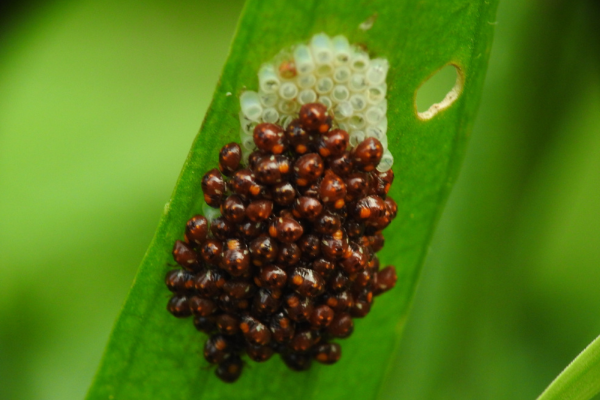Your cart is currently empty!

08 Sep Chinch Bug Life Cycle: From Nymphs To Adults
The chinch bug (Blissus spp.) is a tiny yet troublesome insect that can wreak havoc on lawns and turfgrass. Understanding the life cycle of chinch bugs is essential for effective management and prevention of infestations. In this blog, we will explore the fascinating journey of a chinch bug from its early nymph stage to adulthood, shedding light on its behaviour, development, and the challenges they pose to our beloved lawns.
Stage 1: Egg
The chinch bug life cycle begins when adult females lay their eggs. Typically, chinch bugs overwinter as adults in protected areas, such as leaf litter or garden debris. When temperatures warm up in the spring, these overwintering adults become active and start mating. After mating, the female chinch bug lays eggs in the thatch layer or soil, close to the base of grass plants.
Stage 2: Nymph
Once the eggs are laid, they will incubate for about 1 to 2 weeks before hatching. When the eggs hatch, nymphs emerge, embarking on their journey through five developmental instars. Nymphs are small, red-orange in colour, and lack wings. As they grow, they moult and shed their exoskeletons, each time revealing a slightly larger and more developed version of themselves. The nymphs’ journey through the instars lasts for about 4 to 5 weeks.
Stage 3: Instars
Let’s take a closer look at the different instars the chinch bug nymphs go through:
- First Instar: The first instar nymphs are tiny, measuring around 1/20 inch in size. They are bright red in colour and begin their feeding by inserting their straw-like mouthparts into grass stems and sucking the sap.
- Second Instar: At this stage, the nymphs become larger, reaching approximately 1/16 inch in size. They develop a white band across their abdomens, making them more distinguishable from the first instar nymphs.
- Third Instar: As the nymphs moult into the third instar, they grow to about 1/12 inch in size. Their colouration changes to a mix of red and black, and their wing pads become more prominent.
- Fourth Instar: In the fourth instar, the nymphs continue to grow, reaching around 1/10 inch in size. Their colour becomes darker, and their wing pads continue to develop.
- Fifth Instar: By the fifth instar, the nymphs are nearly fully developed, measuring approximately 1/8 inch in size. They are mostly black with white wing pads and red accents. During this stage, they prepare for their final moult into adulthood.
Stage 4: Adult
After completing the fifth instar, the nymphs undergo their final moult, transforming into adult chinch bugs. The newly developed adults are around 1/6 inch in length, with black bodies and white wings folded over their backs. Male chinch bugs typically have longer and more curved cerci (pincers) than females.
The Impact Of Chinch Bug Life Cycle On Lawns
Chinch bugs are most active and problematic during their nymphal stages, as they feed voraciously on grass sap, causing significant damage to lawns. The feeding behaviour of nymphs can lead to yellowing, browning, and even death of grass blades, resulting in unsightly patches and weakened turf. During the nymphal stages, chinch bugs are also more vulnerable to environmental stressors, such as drought and extreme temperatures. A stressed lawn can provide an ideal environment for chinch bug infestations to thrive, exacerbating the damage they cause.
Understanding the chinch bug life cycle, from eggs to nymphs and finally to adulthood, provides valuable insights into their behaviour and development. Early detection of chinch bug nymphs is essential for implementing effective control measures and preventing significant damage to your lawn. By maintaining a healthy lawn, promoting biodiversity, and taking timely action, you can protect your turf from the impact of chinch bug infestations. Stay vigilant, and may your lawn remain lush, vibrant, and free from the clutches of these pesky insects!
Now that you’ve gained valuable insights into the chinch bug life cycle and the potential damage they can cause to your lawn, it’s time to take proactive steps to protect your turf from these pesky insects. One of the most effective and eco-friendly solutions for managing chinch bug infestations is with Nema Globe Flea & Chinch Bug Buster.
Join the community of homeowners who are embracing eco-friendly solutions and making a positive impact on their lawns and the environment.
Visit the Environmental Factor and reclaim your lawn from chinch bug infestations!


